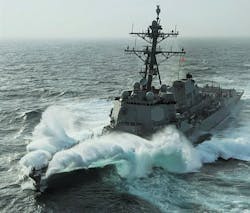Navy wants companies to apply artificial intelligence (AI) and machine learning to weather forecasting
WASHINGTON – U.S. Navy researchers are surveying industry to find companies able to apply artificial intelligence (AI) and machine learning to global weather prediction to track atmospheric processes that influence fleet operations and mission planning.
Officials of the Naval Research Laboratory (NRL) Marine Meteorology Division in Washington released a sources-sought notification (N0017323-RFI-HD01) last week for the Atmospheric Aerosol Prediction and Applications Research and Development project.
This initiative focuses on tropical cyclones like hurricanes and typhoons that can affect naval operations around the world.
Related: The sensor- and signal-processing challenges of electronic warfare
Other goals include AI and machine learning systems development; numerical weather prediction; fine-scale aerosol and cloud prediction; aerosol source characterization; data assimilation of remote-sensing data from aircraft and satellites; providing weather support directly to the warfighter; nowcasting to include model, satellite, and radar data; meteorological applications in decision making; weather influence on piloted and unmanned aircraft; weather effects on shipboard, airborne, and land-based communications, sensors, and weapons; meteorological influence on sensor performance; and atmospheric dispersion of chemical and biological agents.
Navy researchers want the contractor to exchange weather forecasting and other data with University of Washington and National Oceanic and Atmospheric Administration (NOAA), Cooperative Institute for Research in the Atmosphere (CIRA), and Cooperative Institute for Meteorological Satellite Studies (CIMSS), as well as feed information to the Target Acquisition Weapons System (TAWS).
Other goals include analyzing biomass burning plumes, tropical meteorology, and clouds; developing code for testing, data distribution, and documentation; and, participation in routine compliance projects.
Related: Radar keeps a surveillance eye on the battlefield
Researchers also want the contractor to test and review existing codes and standards for creating models, weather research, and forecasting mesoscale models using FORTRAN, C, Python, Perl, MySQL, and IDL software.
The contractor also should support the switch of developed software and databases to operational customers, produce model routines for operational use, and find ways to input data from radar and unmanned aircraft into the system.
Companies interested should email five-page responses no later than 16 Aug. 2023 to the Navy's Brent Robinson at [email protected] and Heather Dinsmore at [email protected].

John Keller | Editor-in-Chief
John Keller is the Editor-in-Chief, Military & Aerospace Electronics Magazine--provides extensive coverage and analysis of enabling electronics and optoelectronic technologies in military, space and commercial aviation applications. John has been a member of the Military & Aerospace Electronics staff since 1989 and chief editor since 1995.

